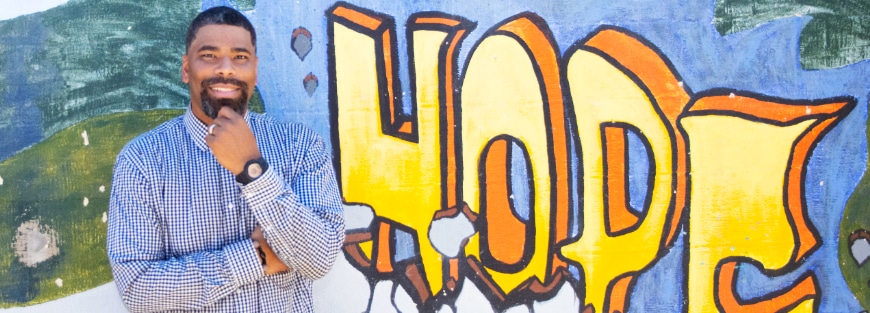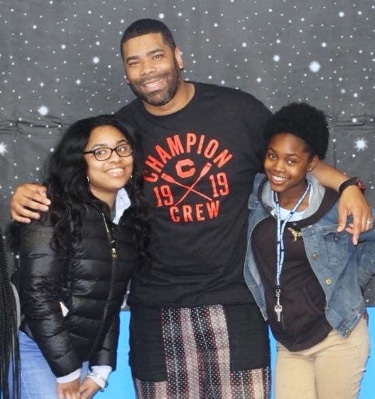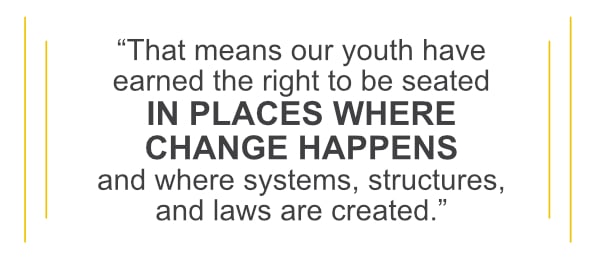Amplifying Young Voices In All The Right Spaces
Posted by: DVULI | October 18, 2021

by Gerald Bell (Kansas City 2003)
Inspiring urban youth to make the world a better place begins by listening to what they have to say. Although social media platforms are a hot spot for young people to speak their minds, there is no guarantee what they are posting, tweeting, and tagging is reaching the right ears and eyes.
 “My dad’s generation used to say that children should be seen and not heard,” recalls Ray Nelson (YFC 2018), a national youth advocacy specialist and leadership trainer. “Through the years, we have become accustomed to building programs for urban youth and determining what they need without inviting them to be a part of their own solutions.”
“My dad’s generation used to say that children should be seen and not heard,” recalls Ray Nelson (YFC 2018), a national youth advocacy specialist and leadership trainer. “Through the years, we have become accustomed to building programs for urban youth and determining what they need without inviting them to be a part of their own solutions.”
According to Nelson, giving youth a voice in places of power means doing the work to “create a culture of love and invite them to environments that are conducive to their growth and ability to speak and be heard.”
Advocating for change, seeking improved conditions, or redirecting systems in any form demands speaking to certain powers, which tends to be a space where many urban young people believe they are neither qualified nor welcome.
“We (urban youth workers) have to challenge our community leaders to change their perception from seeing young people as liabilities to recognizing them as assets,” argues Nelson, who’s been serving youth for nearly 20 years in key positions with World Vision and Youth for Christ. “We use young people to set up tables and chairs but don’t value what God has already put inside them.”
For change and transformation to occur in the communities where urban youth live, learn, play, and advocate, it will require offering them a seat at the table with power players and decision-makers. Being welcomed to the right table (in schools, community organizations, churches, government, etc.) is what Michael Mata, Director of Network Engagement and Leadership Development at TogetherLA, offers as the best way to amplify the voices of young people.
“Youth will definitely tell you what they think these days,” Mata affirms. “But you have to guide, cultivate, and present their concerns in such a way that their passion, energy, and conviction for issues in society and in the community are translated clearly to the authorities in the room.”
Mata points out that one of the top barriers young urban voices must overcome is what’s called adultism. “There are adults who don’t value or appreciate the opinions youth have,” he says. “They are certainly not on their social media platforms [consuming] what youth are saying.”
 Mata adds how he’s observed many adults in official positions who are highly impressed with the way youth articulate their desire for change when the adult takes time to be fully present and listen to what’s on their agenda. “This proves you don’t have to be angry, arguing, rioting, or protesting,” he says. “And that we shouldn’t be underestimating their potential.”
Mata adds how he’s observed many adults in official positions who are highly impressed with the way youth articulate their desire for change when the adult takes time to be fully present and listen to what’s on their agenda. “This proves you don’t have to be angry, arguing, rioting, or protesting,” he says. “And that we shouldn’t be underestimating their potential.”
“First, leaders have got to recognize that our young people bring skill sets, knowledge, fresh ideas, and artistic expression that can reach and influence the culture—as well as their peers—in a way that adults can’t,” insists Nelson. “That means our youth have earned the right to be seated in places where change happens and where systems, structures, and laws are created. Give youth a seat in places of power so they can also learn, discern, and be challenged to be a voice and speak into those processes.”
WHAT’S A YOUTH WORKER TO DO?
Both Nelson and Mata advise that making space for urban youth to illuminate their voice begins with relationships. For instance, Nelson regularly invites youth to accompany him on speaking engagements and to meetings where significant decisions are being made. He believes such mentorship activities build relational trust and expose young advocates to conversations that contribute to the formation of their voice and build upon communication skills and the confidence to speak.
For the urban youth worker who detects that the young people they serve have a message, challenge, or solution to issues that must pass through higher-level positions, Nelson and Mata offer these non-exhaustive recommendations as steps toward building youths’ capacity:
- When convening youth, give attention to how the room is organized. Put chairs in a circle so everyone can see one another, which signifies that the dialogue is completely open with no beginning and end.
- Probe into what youth wish to be different or better in their communities. Ask which issues they want to combat. (This could be something that affects them or their peers.)
- Clarify with youth what they value, so they understand why they feel the way they do.
- Drill down and assess with youth why they think the problem they want to address exists.
- Coach youth on how to express their issues articulately.
- Determine what platforms or audiences are best to release the power of their young voices.
- DVULI alumni should revisit Community Youth Development Workshop materials.
- Google “Community Youth Development” to reference what new resources come up.

